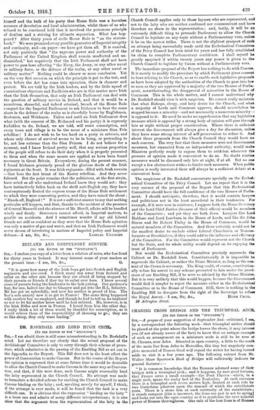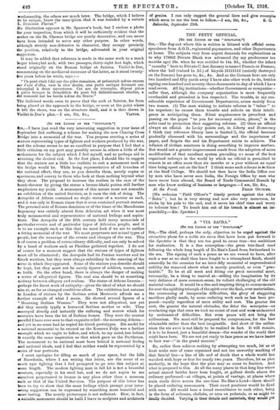CHARING CROSS BRIDGE AND THE TRIUMPHAL ARCH. [To THE EDITOR
OF THE " SPECTATOR:1 Sru,—A propos of your suggestion of September 2nd--criticized, I see, by a correspondent the following week—that triumphal arches should be placed at the point where the bridge loaves the shore, it may interest you (if not already aware of the fact) to know that an antique example of such an arrangement on a miniature scale is still to be seen at St. Chamas, near Arles. Situated in open country, a little to the south of the main line from Aries to Marseilles, this tiny but singularly com- plete memorial of Roman Gaul well repaid the writer for having turned aside to visit it a few years ago. The following extract from Mr. Walter Shaw Sparrow's Book of Bridges will sufficiently indicate its general features :— "it is common knowledge that the Romans adorned some of their bridges with a triumphal arch ; and it happens, by rare good fortune, that France owns a small example—the Pont Flavien—which, in a single arch, spans the rocky bed of the Touloubro. At each entranee there is a triumphal arch seven metres high, flanked at each side by two Corinthian pilasters upon the summit of which the entablature mate. There is a stone lion at each extremity of the entablature ; it stands rampant [this is incorrect, the lions are just in act to spring] and looks out into the open country as if to symbolize the over wakeful power of Roman thoroughness. One only of the four lions is of Roman workmanship, the others are much later. The bridge, which I believe to be unique, bears the inscr iption that it was founded by a certain L. Dominus Flavus."
No illustration appears in Mr. Sparrow's book, but I enclose a photo for your inspection, from which it will be sufficiently evident that the arches on the St. Chamas bridge are purely decorative, and can never have been intended to serve any other purpose. In other words, although strictly non-defensive in character, they occupy precisely the position, relatively to the bridge, advocated in your original suggestion.
It may be added that reference is made in the same work to a much larger triumphal arch, with two passages, thirty-eight feet high, which stood originally on the Roman bridge at Saintes. Vionct-le-Due, eommenting on the mediaeval successor of the latter, as it stood twenty- live years before he wrote, says :—
"Co pent etait tail Bur des piles romaines, et presentait meme encore stir rune d'elles, vers la the droite, une porte antique ferment arc triomphal is deux ouvertures. Cot arc de triomphe, depose piece I piece lorsquo la demolition dm pout fut defunitivement resolue, a ea. remonte sur les bords memo du fieuve."
The italicized words seem to prove that the arch at Salutes, far from being placed at the approach to the bridge, or oven at the point whore It left the shore, was on the structure itself, and it is thus shown in



































 Previous page
Previous page